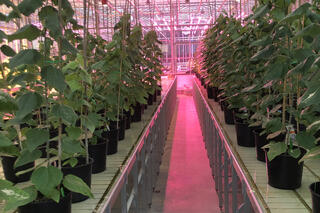Modified poplar with altered lignin composition is more valuable and easier to deconstruct

Genetically engineered poplars showed changes in lignin composition for easier deconstruction and greater sugar yield.
The Science
Lignin, an abundant and complex polymer that gives plants their structural integrity, is the most difficult part of a plant to break down. Deconstructing lignin is one of the key obstacles to extracting sugars from plants for biofuel production. Lignin is composed of building blocks called monolignols. The formation of lignin is a flexible process and scientists have discovered ways to incorporate new building blocks into lignin. By harnessing that flexibility, scientists from the Great Lakes Bioenergy Research Center and the Joint BioEnergy Institute produced a new type of poplar that incorporates a potentially valuable coproduct into its lignin. The resulting poplar wood has reduced lignin content and is easier to deconstruct, leading to an increase in the yield of sugars.
The Impact
This work suggests new ways scientists can engineer bioenergy crops that are more valuable and less expensive to break down.
Summary
Alterations in the lignin biosynthesis pathway are a promising avenue for improving lignin and biomass quality and for producing high-value chemical feedstocks. The expression of bacterial 3-dehydroshikimate dehydratase gene (QsuB) in plants has shown potential for diverting carbon away from the lignin biosynthesis pathway and toward the production of soluble dihydroxybenzoate (DHB), a platform chemical and precursor to high-value products like plastics. In this study, researchers transformed hybrid poplar with QsuB, resulting in transgenic wood with up to 33% less lignin, and an improved saccharification, releasing up to 40% more glucose. Additionally, transgenic poplar produced significant amounts of soluble DHB. These poplars also reveal the novel incorporation of DHB into the backbone of lignin, introducing weaker bonds, or ‘zips’, to the polymers. This work demonstrates how engineering bioenergy crops can not only improve the efficiency of industrial biomass deconstruction by adding cleavable ‘zip-lignin’ but also increase the value of the biomass, as soluble DHB could be a valuable coproduct in future biorefineries.
Program Manager
Shing Kwok
Program Manager, Office of Biological and Environmental Research
shing.kwok@science.doe.gov, 301-903-2977
Corresponding Author
Shawn D. Mansfield
Professor of Wood Science, University of British Columbia
shawn.mansfield@ubc.ca, 604-822-0196
Funding
This work was supported by the Great Lakes Bioenergy Research Center, US Department of Energy, Office of Science, Office of Biological and Environmental Research under award DE-SC0018409, and by the Joint BioEnergy Institute, US Department of Energy, Office of Science, Office of Biological and Environmental Research under contract no. DE-AC02-05CH11231 between Lawrence Berkeley National Laboratory and the US Department of Energy.
Publication
Unda, F., Mottiar, Y., Mahon, E.L., Karlen, S.D., Kim, K.H., Loqué, D., Eudes, A., Ralph, J. and Mansfield, S.D., “A new approach to zip-lignin: 3,4-dihydroxybenzoate is compatible with lignification.” New Phytologist, 235: 234-246 (2022) [DOI: 10.1111/nph.18136]
Related Links
https://doi.org/10.1111/nph.18136